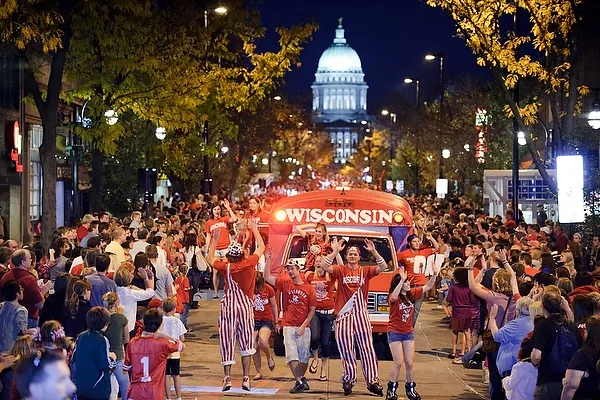
State Street in Madison, Wisconsin
State schools are all the rage for the current and future generation of college students, new data suggests. In a survey of more than 500 students between 18 and 23 who are in college or who plan to attend college, 57% say their sites are set on a state college — an increase from the more than 500 college graduates also surveyed by IonTuition, a financial technology company focused on student loans, which self-reported a state college graduation rate of just 44%. The latter group includes ages 24 to 40+ but skews heavily to 24- to 30-year-olds. Of that group, 49% reported graduating from a private college. But for the younger group, dubbed by IonTuition as “Generation Z,” the rate attending or planning to attend private colleges plummeted to just 18%.
The data, part of a much larger report looking at how Generation Z plans on funding college versus previous generations, matches other studies published recently. Last November, the New York Commission on Independent Colleges and Universities revealed enrollment dropped by 6% for in-state students attending private colleges. In 2016, more than two-thirds of private universities across the U.S. failed to meet enrollment and net tuition revenue targets. Many private liberal arts schools are trying to remedy the growing problem by introducing new majors like data analytics and computational neuroscience. According to data from the National Center for Education Statistics (NCES), total enrollment at U.S. universities dropped 6% from 2010 to 2015 — about 19.3 million students enrolled in 2010 to 17 million in 2015. While attendance at private for-profit colleges surged between 2000 and 2010, attendance dropped by 38% from 2010 to 2015. During the same time of the drop, private nonprofit colleges saw enrollment drop by 6% and enrollment at public colleges decreased 4%.
“Generation Z is less likely to attend a private college,” the report from IonTuition reads. “Understandable, as public schools historically have lower tuition.”
The decrease could come down to simply cost. More than three-quarters (77%) of Generation Z respondents said that cost was either a “defining factor” or “very important” when it comes to deciding which college to attend. The rate was a slight uptick from 70% of the current workforce that said cost was a defining factor or very important when deciding where to attend college. “Many students choose to attend a more affordable school rather than apply to more expensive options, even those that may have otherwise been a better fit,” the report reads.
No doubt, debt is a growing issue in the country. Today (March 1), Federal Reserve Chairman Jerome Powell said the growing level of student debt could actually slow down the economy in upcoming years. Some 38% of students attending college during the 2015-2016 academic year took an average of $14,000 in student loans, according to data published by the NCES last month. If that rate continued over the typical four years to graduate, that’s more than $50,000 in student loan debt at time of graduation.
“The student loan crisis spans several generations,” the IonTuition report reads. “Over half of college students believe their parents’ student loans impacted their ability to help with college costs. If this pattern continues, the emerging workforce will be unable to assist their own children, creating a cycle where each generation’s loans make it harder on the next unless support is put in place to break the cycle.”











Questions about this article? Email us or leave a comment below.